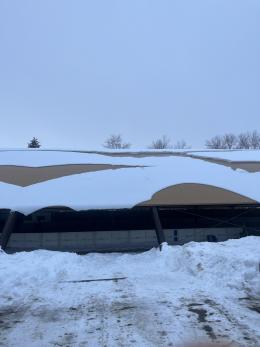Good morning. This is Dave Zinn with the Gallatin National Forest Avalanche Forecast on Monday, December 26th at 7:15 a.m. This information is sponsored by Cooke City Motorsports, Stronghold Fabrication, and Alpine Orthopedics & Sports Medicine. This forecast does not apply to operating ski areas.
Nice won out, and the mountains received 2-4” of new snow across the advisory area yesterday. This morning, mountain temperatures are in the 20s F with 10-20 mph wind from the west to the southwest. Today, temperatures will be in the 30s F with 10-20 mph winds from the south to the southwest. Cooke City and West Yellowstone may get an inch of snow tonight, but the rest of the advisory area will have to wait until tomorrow for new snow.
Yesterday, the mountains across the advisory area received 2-4” of heavy snow equal to 0.2 to 0.4” of snow water equivalent (SWE). Consider three avalanche-related concerns you could encounter in the mountains today.
- Most likely are avalanches breaking 3-8” deep in the new and wind-drifted snow. These may be relatively small, but terrain traps like trees, cliffs or rocks amplify the danger.
- A recently buried weak layer about a foot deep yielded unstable results in Doug and Alex’s snowpits at Lionhead (video, observation) and Buck Ridge, where a group of riders reported the same weak layer (observation). This thin layer of weak snow creates the potential for avalanches to propagate, or spread, across wider areas. You can help us map the extent of this weak layer by digging a snowpit and letting us know if you find a strip of sugary snow 1-3” thick buried a foot deep and telling us if it fails and propagates during your assessment. If you find this instability, avoid avalanche terrain.
- Weak layers buried 3-6 feet deep, depending the total depth of the snow, make large avalanches breaking near the ground an unlikely but dangerous possibility (last week’s Cooke City video). During avalanche mitigation work yesterday, the Big Sky Ski Patrol triggered a small but deep avalanche showing that it remains with us even though the last human-triggered deep slab avalanche in the backcountry was a couple of weeks ago (details).
Doug gave us some good advice that applies to all of these concerns in his video from Hebgen Lake last week, “Dig and test. If there is any doubt, stay out of avalanche terrain.”
Human-triggered avalanches are possible, and the danger is rated MODERATE.
Roof Avalanches: Yesterday, many slick roofs in the valley shed the winter’s snow. Avoid playing under sloped metal roofs still holding snow (photo).
Please share avalanche, snowpack or weather observations via our website, email (mtavalanche@gmail.com), phone (406-587-6984), or Instagram (#gnfacobs).
Today, consider three avalanche-related concerns in Island Park. First are slides breaking 3-8” deep in wind-drifted snow. Second is a weak layer buried one foot under the surface that demonstrated instability nearby at Lionhead Ridge (video, observation). We will assume it exists in the Centennial Mountains until proven otherwise. And third, large avalanches failing on weak layers buried near the ground are an unlikely but dangerous possibility. Dig down, test for instability, and if there is any doubt, stay out of avalanche terrain because dangerous, human-triggered slides are possible.
Upcoming Avalanche Education and Events
Our education calendar is full of awareness lectures and field courses. Check it out: Events and Education Calendar.
Thursday, December 29, 6:30 p.m., Avalanche Presentation and Raffle (great odds of winning!) at MAP Brewing in Bozeman. Free.
January 4 + field day on January 7 or 8, Avalanche Fundamentals for Snowmobilers, Information and pre-registration HERE.
January 4 + field day, Avalanche Fundamentals for Skiers and Snowboarders, Information and pre-registration HERE.
Every Saturday, 10 a.m. - 2:00 p.m. Avalanche Rescue Training, drop in for any amount of time. Round Lake Warming Hut, Cooke City. Free.
Please consider donating to the Friends of GNFAC Annual Fundraiser.
There are new avalanche beacon checkers at Portal Creek and the trailhead to Denny Creek/ Lionhead Ridge. Thank you the Gallatin Valley Snowmobile Association and Hebgen District FS snow rangers for installing these community resources.



